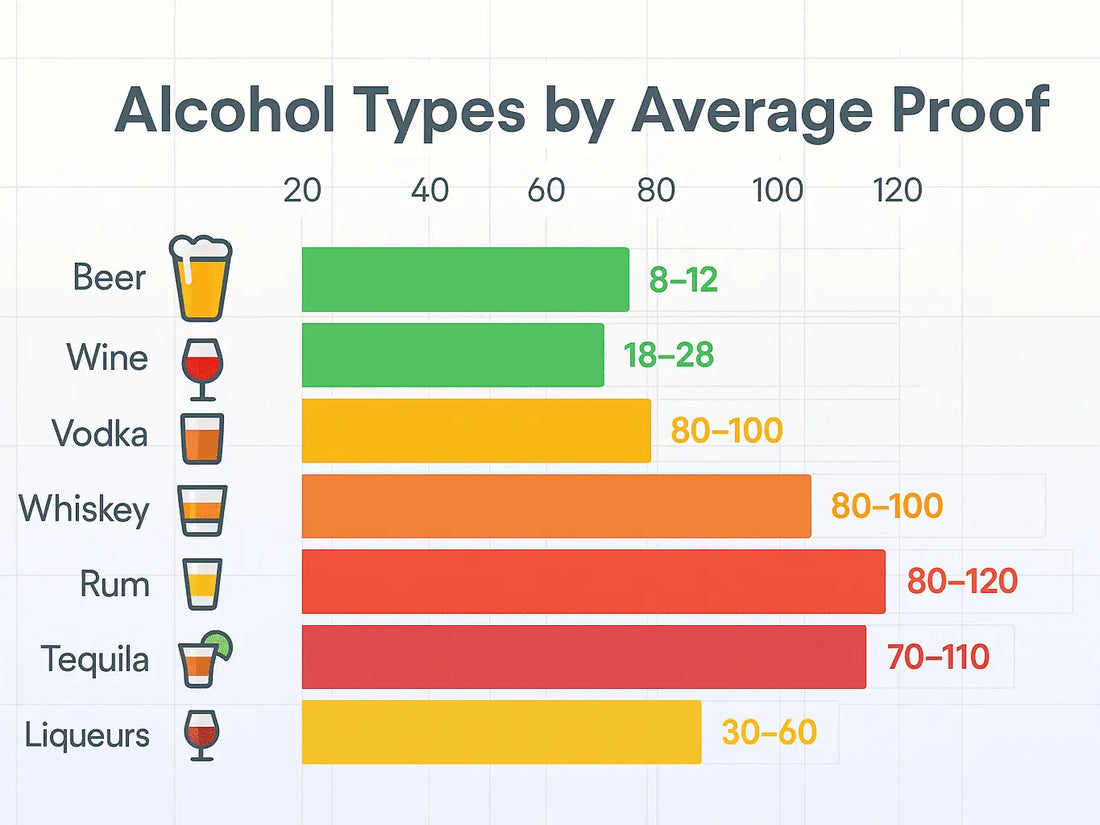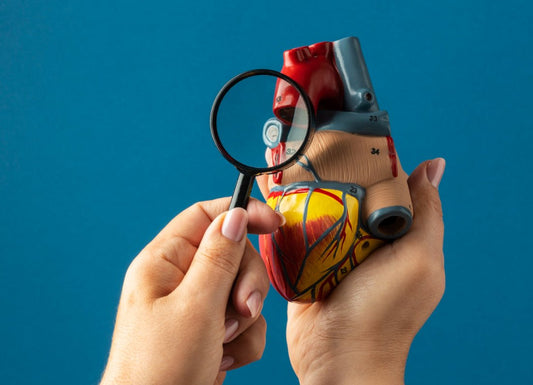What Is Proof in Alcohol? How This Number Impacts Your Health and Liver
 Written By
Abel Tamirat, MD
Written By
Abel Tamirat, MD

What you need to know about alcohol strength and your well-being
Have you ever picked up a bottle labeled “80 proof” and wondered what that really means for your health? If you're someone living with liver concerns, managing metabolic conditions, or just trying to make healthier choices, understanding alcohol proof is a helpful step toward protecting your well-being.
In this comprehensive guide, we’ll explore what alcohol proof really is, how it affects your liver, and practical ways to make alcohol choices that align with your health goals. Whether you drink occasionally or are reassessing your relationship with alcohol, this article is here to help.
What does alcohol proof mean?
In the simplest terms, proof measures the strength of an alcoholic beverage. In the U.S., proof is calculated by doubling the ABV (alcohol by volume):
Proof = ABV × 2
So if a drink has 40% ABV, it's 80 proof. That means 40% of the liquid is pure ethanol—the type of alcohol your liver processes.
Why it matters
Stronger drinks aren’t just more potent in flavor—they deliver more ethanol per sip. This has real implications for your liver, your overall health, and even your mood.
The surprising origin of alcohol proof
The idea of “proof” dates back to the 1500s in England. At the time, tax collectors needed to know if a spirit was strong enough to warrant a higher tax. Their solution? A flammable test. They would mix a sample of the liquor with gunpowder and ignite it. If it burned, it was deemed to be "proof" of strength.
Eventually, this method was replaced with specific measurements. In the UK, 100 proof used to equal 57.15% ABV. The U.S. adopted a simpler formula: proof is just twice the ABV.
ABV vs. proof: what’s the difference?

Though they describe the same thing—alcohol content—ABV and proof are not interchangeable.
|
Measure |
What it tells you |
Where you'll find it |
|
ABV |
The % of pure alcohol in a beverage |
On all beer, wine, and spirit labels |
|
Proof |
Twice the ABV (U.S. only) |
Typically found on spirits |
In many other countries, you’ll only see ABV. Proof remains mostly a U.S. convention.
Alcohol types and their typical proof levels
Here's how common alcoholic beverages compare by strength:
|
Beverage |
Average ABV |
Average Proof |
|
Beer |
4–6% |
8–12 |
|
Wine |
9–14% |
18–28 |
|
Vodka |
40–50% |
80–100 |
|
Whiskey |
40–50% |
80–100 |
|
Rum |
40–60% |
80–120 |
|
Tequila |
35–55% |
70–110 |
|
Liqueurs |
15–30% |
30–60 |
Overproof spirits—often used in cocktails or specialty liquors—may exceed 100 proof and contain much higher levels of ethanol.
How your liver handles alcohol
Your liver is your body’s detox center. It processes toxins, including alcohol. On average, your liver can process about one standard drink per hour. A standard drink contains approximately 14 grams of pure alcohol.
Here’s what counts:
-
12 oz of beer (5% ABV)
-
5 oz of wine (12% ABV)
-
1.5 oz of spirits (40% ABV)
Drinks with higher proof require more effort from your liver to process, which can lead to stress and potential damage.
Health effects of high-proof alcohol

Regularly consuming high-proof spirits can overwhelm the liver’s natural detox system. Over time, this can lead to:
-
Fat accumulation in liver cells (steatosis)
-
Inflammation of liver tissue (hepatitis)
-
Permanent scarring (cirrhosis)
-
Elevated liver enzymes and reduced function
Even moderate alcohol intake has been linked to a higher risk of certain cancers and heart conditions when high-proof drinks are involved.
Learn more about how alcohol affects your liver.
Alcohol and metabolic health
Proof doesn’t just affect the liver—it impacts metabolism. High-proof alcohol:
-
Increases calorie intake
-
Disrupts insulin sensitivity
-
May worsen type 2 diabetes symptoms
-
Interferes with medications for cholesterol and blood pressure
For individuals living with metabolic syndrome, lowering proof (or abstaining) can help support weight loss, glucose control, and inflammation reduction.
For related insights, you can check out how to monitor glucose levels at home.
Who should avoid high-proof alcohol?
You may benefit from limiting or avoiding high-proof alcohol if you:
-
Live with non-alcoholic fatty liver disease (NAFLD)
-
Have a history of alcohol use disorder
-
Manage type 2 diabetes or insulin resistance
-
Take liver-sensitive medications (e.g., statins, acetaminophen)
-
Are pregnant or breastfeeding
If any of these apply, talk with your healthcare provider about safe alcohol options, or whether abstaining is best for your goals.
Also see: Does Fatty Liver Cause Weight Gain?
Practical tips for choosing alcohol wisely
You don’t have to cut out alcohol entirely to be mindful. Here are some ways to manage your intake:
-
Stick to lower-proof drinks like wine, beer, or low-ABV spirits
-
Mix spirits with water or soda to reduce concentration
-
Alternate with non-alcoholic drinks to pace yourself
-
Read the label carefully—don’t assume all vodkas or whiskeys are the same
Pro tip: Create alcohol-free rituals
Many people find success with “mindful drinking.” Try:
-
Mocktails with fresh herbs
-
Sparkling water with fruit
-
Herbal teas in social settings
You can still enjoy the ritual without the proof.
What to do if you're cutting back or quitting

Whether you're sober-curious or committed to quitting, it's helpful to:
-
Track your drinking with a journal or app
-
Seek support from groups or friends
-
Talk to your doctor about liver testing or counseling
Get started with Ribbon Checkup’s liver health resources, including at-home liver tests and educational articles tailored to people like you.
Talking to your doctor about alcohol use
Don’t wait for symptoms to show up. If you have concerns about alcohol or liver function, consider asking your provider:
-
“How much alcohol is safe for me?”
-
“Should I get my liver enzymes checked?”
-
“Can I take this medication with alcohol?”
Open conversations can lead to early detection and better outcomes.
The bottom line
Alcohol proof is more than a number on a bottle—it’s a measure of how much stress your liver will handle.
By understanding what proof means, you gain more control over how alcohol fits into your life. Whether you're drinking socially, trying to cut back, or avoiding it altogether, knowing the strength of your drink is an empowering first step.
Small shifts—like choosing lower-proof beverages or taking regular alcohol-free days—can have a big impact on your liver and your long-term health.
Your next step with Ribbon Checkup
Wondering how alcohol is impacting your liver right now? Check out Ribbon Checkup’s at-home liver test kits to get personalized insights without leaving home.
Related Resources
References
CDC. (2024, December 12). About Standard Drink Sizes. Retrieved May 17, 2025, from Alcohol Use website: https://www.cdc.gov/alcohol/standard-drink-sizes/index.html
CDC. (2025, February 25). Alcohol Use and Your Health. Retrieved May 17, 2025, from Alcohol Use website: https://www.cdc.gov/alcohol/about-alcohol-use/index.html
Health, & Study, C. (2025). Information about Alcohol. Retrieved May 17, 2025, from Nih.gov website: https://www.ncbi.nlm.nih.gov/books/NBK20360/
Loeppky, J. (2023, May). What Does the Proof on Certain Types of Alcohol Mean? Retrieved May 17, 2025, from Healthline website: https://www.healthline.com/health/what-does-the-proof-on-alcohol-mean
Paton, A. (2005). Alcohol in the body. BMJ, 330(7482), 85–87. https://doi.org/10.1136/bmj.330.7482.85
Sherrell, Z. (2023, April 11). Alcohol proof: What does it mean? Retrieved May 17, 2025, from Medicalnewstoday.com website: https://www.medicalnewstoday.com/articles/what-does-the-proof-on-alcohol-mean

Dr. Abel Tamirat is a licensed General Practitioner and ECFMG-certified international medical graduate with over three years of experience supporting U.S.-based telehealth and primary care practices. As a freelance medical writer and Virtual Clinical Support Specialist, he blends frontline clinical expertise with a passion for health technology and evidence-based content. He is also a contributor to Continuing Medical Education (CME) programs.



